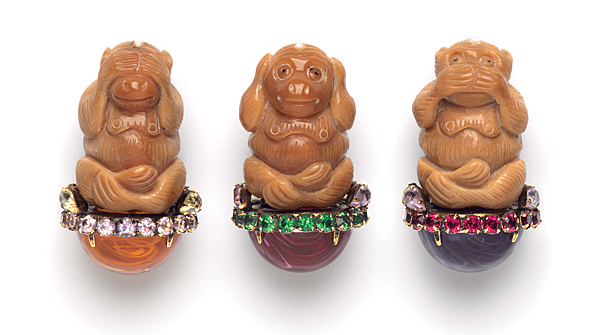Dr. Madeleine Albright, the 64th Secretary of State of the United States and a formidable collector of jewelry, was a rather unique advocate for the strategic and provocative use of pins. Her love affair with jewelry, while not new to her, erupted on the political scene in 1994 while she was ambassador to the United Nations for the Clinton administration. Albright, who had just been described by the national Iraqi newspaper as an “unparalleled serpent,” was scheduled to meet with Iraqi officials. “What to wear?” she recalls in her jewelry memoirs.
Dr. Albright’s choice of a small gold and diamond snake pin made diplomatic history. “It was just my way of sending a message,” she told the UN press corps. In subsequent years, as she rose to political prominence, the impact of her choices of “what to wear” grew. In turn chiding and wishful, her pins were soon read as personal narrative scholia to her official visits to heads of state.
Read my Pins, Albright’s jewelry memoir published in conjunction with the eponymous show at New York’s Museum of Arts and Design, bears testimony to the Secretary’s awareness of jewelry’s long history as a propaganda tool. In fact, this woman’s choice of a flag, an eagle, or a dove would amount to a footnote in that history, were it not for the conjunction of three factors: being a Secretary of State gave her picks unparalleled exposure; being a woman meant she could vastly expand on the rather limited range of masculine ornament; and being who she was meant she was rather less than subservient to diplomatic etiquette.
She will now take your questions.

Agita Putaane, Riga, Latvia: Your jewelry pieces are your lips for the public. Do you have any jewelry that is just for you? That doesn’t communicate anything to anyone else?
Dr. Madeleine Albright: I have many different pins that I have bought or that have been given to me over the years simply because they are pretty or well-crafted or just plain fun. Sometimes it’s nice to wear a piece for its own sake without trying to communicate any specific message.
The piece of jewelry that is by far the most personal to me is a heart-shaped pin made of clay and painted haphazardly in bright colors. It was given to me one Valentine’s Day by my then-five-year-old daughter Katie. To the casual observer, it is neither expertly crafted nor particularly valuable. But to me, it symbolizes the unbreakable bonds of love between mother and daughter and is therefore infinitely precious.
Susan Cummins, Tiburon, California: Did you find that there were various ways to read a pin’s symbolic meaning based on different cultural points of view? Did this ever get you in trouble?
Dr. Madeleine Albright: I am pretty careful about not wearing things that are insulting—that’s an important part of being a diplomat. On the contrary, I try to wear things that are representative of the place that I am visiting. I have a whole hanging bag of pins that are actually organized by their country of origin. I particularly like a pin that was given to me in Lebanon, which is my name in Arabic. In that case, I had to do some research to make sure it really was my name in Arabic and not some other word that might be embarrassing. Luckily, it really did say “Madeleine.”
Marthe Le Van, Asheville, North Carolina: During your service as Secretary of State, did you come across dignitaries who met pin with pin, answering the “mute eloquence of pins with attitude” with ornaments of their own?
Dr. Madeleine Albright: Interestingly enough, I have come across quite a lot of men that wear lapel pins signifying their position in government or representing their party affiliation. For instance, most members of communist parties identify themselves by wearing specific pins. In our own government, many members of Congress often wear pins on their lapel featuring the American flag or the Congressional seal.

Dr. Madeleine Albright: There was one instance where my choice of pins got me into trouble. I had traveled with President Clinton to Moscow to meet with President Vladimir Putin, and among a number of issues I wanted to raise was Russia’s feigned ignorance of human rights abuses in Chechnya.
To show my displeasure, I wore three monkey pins representing the “see no evil, hear no evil, speak no evil” adage. While walking into a meeting, President Putin turned to President Clinton and remarked that the Russians always took great interest in what pins I wore and what they might symbolize about the US-Russian relationship. He then asked me what my monkeys were supposed to signify.
I replied point blank that I thought his policies regarding Chechnya were “pure evil.” The resulting look on President Clinton’s face made it clear that I had taken my pins a bit too far on that occasion.

Joan Dutton, Chicago, Illinois: What brooch would you wear to a meeting with President Vladimir Putin? With President Bashar al-Assad?
Dr. Madeleine Albright: In lieu of wearing the monkeys again, I think I would wear a very large American flag when meeting with President Putin to signify the enduring strength of American ideals.
I wore a lion the first time I met President Assad’s father Hafez al-Assad, because Assad means “lion” in Arabic. However, I think a more apt pin would have been a mule due to his stubbornness. In his son’s case, I would probably wear a scorpion to depict how he has hurt the Syrian people.
Bella Neyman, New York, New York: How much of her own opinion is a Secretary of State expected (or allowed) to pack in her diplomatic bag and express in public? Did your use of pins—your “personal diplomatic arsenal”—ever come under criticism by your administration for being too personal?
Dr. Madeleine Albright: As Secretary of State, I was a member of the presidential cabinet as well as the national security team. Part of my job was to help formulate the foreign policy of the United States, and ultimately I was responsible for packing my own diplomatic bag. The pins were just one particular tool that I used to reinforce the message of the day.

Donald Wallens, Los Angeles, California: Having had the pleasure of seeing your jewelry collection at the Clinton Library, I wondered how you feel about it as a museum display, disembodied rather than adorning your self?
Dr. Madeleine Albright: Actually, I love it! I am always surprised at how beautifully the various museums display the exhibit. Each one has done it a little differently in terms of spacing and lighting, but the result is always stunning.
While I was able to find duplicates of some of the pins and continue to wear them, many of the ones on display are custom or vintage pieces, and so I’ve had to let them go. I do miss them at times, but I am glad that others have the opportunity to see them and learn more about the nuances of foreign policy as a result.
Benjamin Lignel, Montreuil, France: Your collection, while coming from a wide range of sources, bears witness to a particular penchant for costume jewelry. What qualities does it have that more upmarket pieces lack? Are you interested in commissioning work from living jewelers and artists, or do you prefer the adventure of shopping?
Dr. Madeleine Albright: I really enjoy combing through flea markets and bazaars in search of pins that catch my eye or speak to me in some way. It’s great fun.
One of the reasons I traditionally opt for costume jewelry is because of the price. And while I hate the idea of losing any of my jewelry, I suppose that at least with costume pieces the loss would hurt a little less. I also appreciate the accessibility of costume jewelry, because I want to make it clear that anyone can do what I’ve done with my pins. I believe that jewelry doesn’t have to come from a fancy store or be made of precious gems to have a powerful, personal significance.
Thanks!




